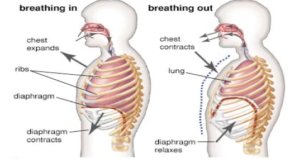Breathing
Most people use only a fraction of their lung capacity for breathing. They breathe shallowly, barely expanding the ribcage. Their shoulders are hunched, they have painful tension in the upper part of the back and neck, and they suffer from lack of oxygen.
The three basic types
- Clavicular breathing is the most shallow and worst possible type. The shoulders and collarbone are raised while the abdomen is contracted during inhalation. Maximum effort is made, but a minimum amount of air is obtained.
- Thoracic breathing is done with the rib muscles expanding the rib cage, and is the second type of incomplete breathing.
- Deep abdominal breathing is the best, for it brings air to the lowest and largest part of the lungs. Breathing is slow and deep, and proper use is made of the diaphragm.
Actually, none of these types is complete. A full Yogic breath combines all three, beginning with a deep breath and continuing the inhalation through the intercostal and clavicular areas – more details can be found at Yoga & Inner Peace.


Breathing
click here.
How to control our emotions through proper breathing
When we are emotional, breathing is on the “automatic pilot.” As we are focused on the object of our emotion, we hardly every consciously register the close relationship between emotions and breathing. When we are angry, fearful, or anxious, we over-breathe or as one would say in common parlance, we “huff and puff”.
In case of sadness, suspense, conflict or depression, we under-breathe, “hold our breath,” so to say. These changes in the breathing are automatic. Incidentally, there is a chain reaction of other physical changes, such as the release of chemicals, sympathetic, and parasympathetic nervous system activity, which accompany the changes in the breathing.
Why do we choose to talk about the relationship between emotions and breathing? Because breathing is a unique bodily function that can be “automatic,” that is, it can function on its own, without our deliberate effort to breathe and it can also be a conscious, “self-directed” and voluntary activity.
With deep abdominal breathing we can heal our bodies, our minds and our emotions. Most of us are stuck in poor breathing habits which are limiting us.
Also see Breathwork Techniques for Healing and Stress Relief.
